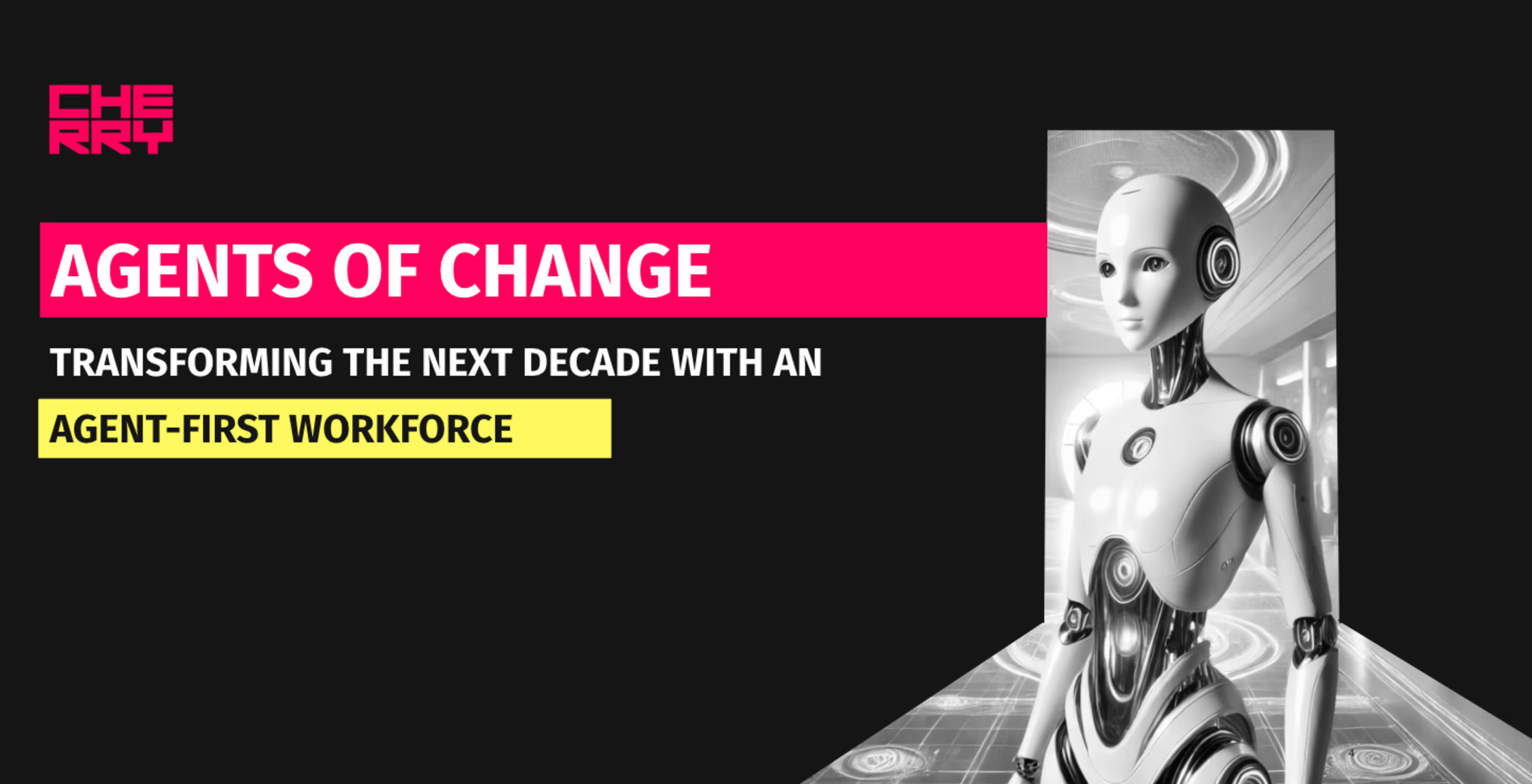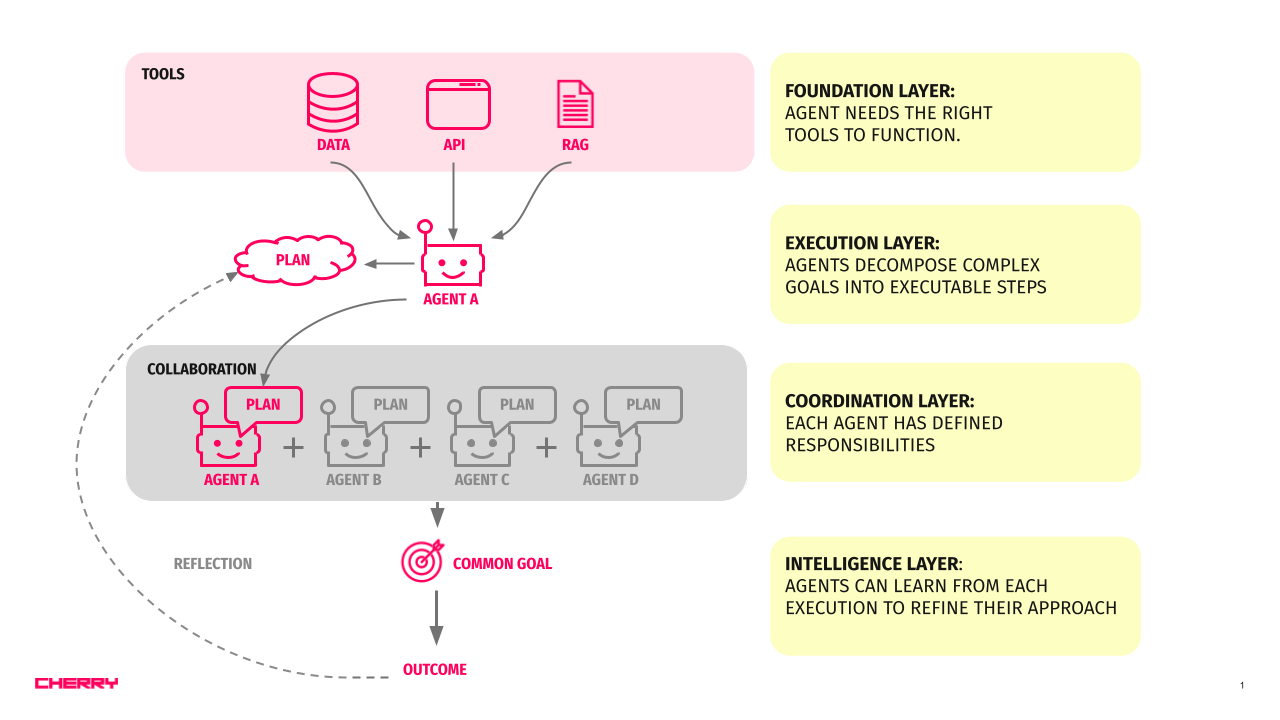Written by Jasper Masemann, Nadja Reischel & Lutz Finger
Agents of Change: Transforming The Next Decade With an Agent-First Workforce
A technical guide to building AI agents, from core architecture through scalable implementation. Written for founders, Cherry Ventures' investment perspective reveals practical insights from portfolio companies, highlighting why agent-first design matters for the next wave of enterprise software.

The next emerging paradigm is Agentic AI - systems that can independently complete complex tasks without constant human oversight. Unlike traditional AI that makes predictions and requires human direction, agents - at least so the hope - execute entire workflows autonomously within defined constraints. Similar to previous hype cycles like robotic process automation (RPA), there's a strong belief in the potential for substantial automation. While we acknowledge that today's agentic approaches are still in their infancy, we nonetheless agree that the potential is immense. The market is betting heavily on this future and so do we at Cherry Ventures.
In the US, /dev/agents, founded by former Stripe CTO David Singleton, secured $56 million in seed funding from Index Ventures to develop an operating system for AI agents. In Europe, Tessl, founded by Snyk creator Guy Podjarny, raised $100 million at a $750 million valuation to transform software development with AI. Similarly, Nustom, co-founded by Monzo’s Jonas Templestein, is gaining traction with its AI-driven custom software solutions. Additionally, foundational model providers create agentic workflows on top of their Large Language Models. OpenAI is launching ‘Operator,’ an autonomous developer tool. Anthropic is beta-testing its ‘computer use’ capabilities, and Google is advancing similar technologies.
Just as cars didn't simply replace horses but transformed how cities were built, successful agent companies will redefine work processes from first principles.
The opportunity is not in layering AI onto existing human-centric workflows - that's just expensive automation. Instead, startups can reimagine work for an agent-first world with. Crucially, they present a unique opportunity to tap into broader employee and services budgets - not just software spend - by freeing up resources and enabling teams to focus on strategic work.
Considerations for Founders Building Agents
Agents are systems designed for autonomous execution with clear objectives and controlled workflows. Their architecture can be understood in distinct layers, each building on the capabilities of those below:
1. Foundation Layer: Agents need the right tools to function.
This means having access to the right data, RAG systems for dynamic knowledge access, APIs for system interaction, and robust logging infrastructure. These tools form the basic building blocks that enable all higher-order capabilities.
2. Execution Layer: Agents plan.
Agents decompose complex goals into sequential, executable steps. Using techniques like tree-of-thought reasoning and structured workflows, they map out their approach before taking action. This creates predictable, verifiable execution paths rather than black-box decision making.
3. Coordination Layer: Agents collaborate.
Through multi-agent architectures, complex tasks are distributed across specialised components. Each agent has defined responsibilities - data retrieval, analysis, verification - working together through structured protocols. This enables handling of workflows too complex for any single agent.
4. Intelligence Layer: Agents Reflect.
Agents monitor their own performance, validate outputs, and adjust strategies based on results. They maintain feedback loops for continuous improvement, learning from each execution to refine their approach. This self-assessment and adaptation is what makes agents truly autonomous.
Tools enable planning, planning enables collaboration, and collaboration enables intelligent execution; assembling these four layers forms the agent stack.

From an investment perspective, a founding team's approach to this architecture often reveals their technical maturity and go-to-market potential. Their early decisions around modularity, scalability, and reliability typically determine how quickly they can deliver customer value.
Best Practices for Founders
For founders aiming to build and deploy agents, it's crucial to identify the minimum quality product required for your specific workflow. Focus narrowly on solving a well-defined problem with one or multiple agents, rather than attempting to address a broad scope. Once you've pinpointed your problem space and established the quality benchmarks you need to meet, proceed with the following steps:
Modular Architecture
Designing agents with modular components allows for greater scalability and flexibility. Using approaches like Directed Acyclic Graphs (DAGs), agents can dynamically orchestrate tasks, enabling complex, non-linear workflows—unlike RPA's mostly linear processes. This allows agents to adapt to large datasets and increased workloads without compromising performance. While RPA workflows are modular by definition, they often become unwieldy due to the complexity of human tasks. Agents handle this complexity more effectively, enabling companies to scale operations without system overhauls and adapt quickly to market changes. However, predicting the next best task involves navigating statistically uncertain general knowledge—an issue yet to be fully resolved. Founders must decide whether to build these AI-infrastructure components in-house or purchase them.
Hybrid Rule Engines
Combining rule-based systems with AI learning leads to more robust agents. These systems ensure agents operate within guidelines, while AI learning allows them to adapt to new situations and optimise performance over time. However, it's important to acknowledge that an over-reliance on rigid rules is precisely why RPAs became inflexible in the first place; while necessary, these rules can limit adaptability, highlighting the need for an agent-first approach that prioritises evolution over static directives.
Different types of agents serve different needs:
- Reactive agents respond to changes without internal modeling, suitable for simple real-time decisions.
- Deliberative agents use internal models to plan and reason, ideal for complex problem-solving.
- Hybrid agents balance responsiveness and reasoning.
- Multi-agent systems enable collaboration on complex tasks.
Scalable and Reliable Performance
Optimising performance is key to building scalable agents. Efficient algorithms and cloud resources ensure consistent performance under heavy workloads; load balancing across multiple agents prevents bottlenecks; RAG improves performance by efficiently managing data retrieval and processing.
Reliability requires anticipating failures and implementing contingency measures, such as escalating unresolved tasks to human operators. Agents must function effectively even during system failures, with redundancy and robust error-checking ensuring continued operations. This is especially crucial as we see more and more early-stage startups experiencing explosive growth due to the incredible distribution approaches in GTM available to founders (nowadays).
Implementation Strategy by Use Case
Implementing agents requires an approach tailored to the specific demands of the company founders are trying to build to ensure maximum effectiveness. In high-stakes domains like finance or healthcare, longer sales cycles and larger contracts require human oversight and validation rules. These markets reward patience, as agents must provide clear confidence scores and detailed audit trails, trading speed for reliability and building competitive advantages through expertise and compliance.
Process automation offers a straightforward path to revenue by targeting repetitive workflows with demonstrable ROI. Our most successful portfolio companies in this space identify high-friction niche processes and build targeted solutions that deliver measurable value within weeks. This focused approach leads to shorter sales cycles and stronger customer references.
In knowledge work applications, prioritising accuracy over speed is crucial. By building feedback loops and effective human-agent interfaces, companies gain compounding advantages from their data. The most compelling solutions improve exponentially with each customer interaction, positively impacting retention rates and expansion revenue.
Ultimately, many agent applications aim to replace employees to become attractive venture opportunities. Once an MVP is operational, securing at least one customer willing to pay the lower end of an annual salary for the use case is essential. Failure to achieve this may indicate the problem is not urgent enough for the budget owner.
The Future of Agent Technology and Our Investments
The enterprise software market is at an inflection point as agents transition from experimental projects to production-ready systems. The race is on, with major AI labs are shifting investments from language models to autonomous execution to capture the next wave of enterprise value.
Three key drivers are accelerating adoption:
- Technical Maturity: Advances in reasoning, RAG systems, and computer control are making agents reliable for mission-critical tasks. They handle unstructured data and adapt to changing processes, overcoming limitations of previous automation attempts..
- Market Readiness: Rising labor costs and increasing process complexity push enterprises toward scalable automation solutions. While the $250 billion business process outsourcing market is a clear target, the real opportunity lies in transforming work across the organisation.
- Economic Imperative: Traditional automation approaches have reached their limits. RPA's rigid workflows fail under complexity, and human-intensive processes can't scale efficiently. Agents offer genuine operational leverage through adaptable, intelligent automation.
At Cherry Ventures, we have invested in companies building the future of work with AI agents:
- Stealth (software reliability): Automates manual work of engineers, remembering how things broke in the past and resolves them faster. The agent automatically identifies failure patterns, creates postmortem reports, and predicts how future incidents can best be mitigated.
- Octomind: Automated software testing. Engineers describe how their frontend should look, agents generate and maintain test cases. Eliminates reliance on QA engineers (currently 1/6th of technical workforce).
- Stealth (call automation): Agents call double-opt-in customers to solve requests.
- Stealth (IT audit): Automated IT auditing. Agents use LLMs and classical NLP to verify documents and data, saving massive time per audit.
- Stealth (cybersecurity): Intelligent cybersecurity prioritisation. Agents automatically rank thousands of daily security alerts based on enterprise policies and compliance frameworks.
We seek companies that address urgent, expensive problems in large markets with scalable technology that improves over time. Success requires building defensible positions in specific verticals or horizontal capabilities while effectively managing human-agent collaboration.
Agents are evolving from tools to genuine digital co-workers in the next decade. Companies that navigate this transition successfully – building reliable, scalable, and transparent systems – will create immense value by reimagining from the ground up how work is done.